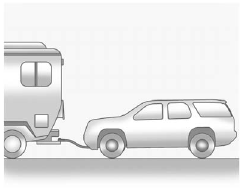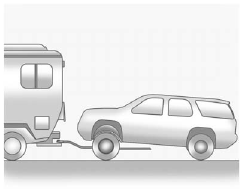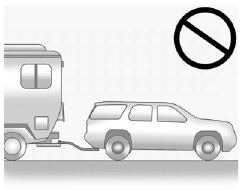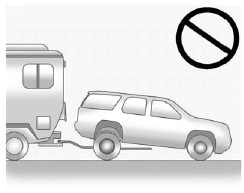GMC Terrain: Towing
Towing the Vehicle
Notice: To avoid damage, the disabled vehicle should be towed with all four wheels off the ground. Care must be taken with vehicles that have low ground clearance and/or special equipment. Always flatbed on a car carrier.
Consult your dealer or a professional towing service if the disabled vehicle must be towed. See Roadside Assistance Program (U.S. and Canada) on page 13‑7 or Roadside Assistance Program (Mexico) on page 13‑9.
To tow the vehicle behind another vehicle for recreational purposes, such as behind a motor home, see “Recreational Vehicle Towing” in this section.
Recreational Vehicle Towing
Recreational vehicle towing means towing the vehicle behind another vehicle – such as behind a motor home. The two most common types of recreational vehicle towing are known as dinghy towing and dolly towing. Dinghy towing is towing the vehicle with all four wheels on the ground. Dolly towing is towing the vehicle with two wheels on the ground and two wheels up on a device known as a dolly.
Here are some important things to consider before recreational vehicle towing:
○ What is the towing capacity of the towing vehicle? Be sure to read the tow
vehicle manufacturer's recommendations.
○ What is the distance that will be travelled? Some vehicles have restrictions on
how far and how long they can tow.
○ Is the proper towing equipment going to be used? See your dealer or trailering
professional for additional advice and equipment recommendations.
○ Is the vehicle ready to be towed? Just as preparing the vehicle for a long trip,
make sure the vehicle is prepared to be towed.
Dinghy Towing
Front-wheel&-drive and all-wheel-drive vehicles may be dinghy towed from the front. These vehicles can also be towed by placing them on a platform trailer with all four wheels off of the ground. For other towing options, see “Dolly Towing” following in this section.
For vehicles being dinghy towed, the vehicle should be run at the beginning of each day and at each RV fuel stop for about five minutes. This will ensure proper lubrication of transmission components.

To tow the vehicle from the front with all four wheels on the ground:
1. Position the vehicle that will be towed and secure it to the towing vehicle.
2. Turn the ignition key to ON/RUN.
3. Shift the transmission to N (Neutral).
4. Turn the ignition key to ACC/ ACCESSORY.
5. Turn all accessories off.
6. To prevent the battery from draining while the vehicle is being towed, remove fuse 32, the Discrete Logic Ignition Switch fuse, from the instrument panel fuse block and store it in a safe location. See Instrument Panel Fuse Block on page 10‑42.
Notice: If the vehicle is towed without performing each of the steps listed under “Dinghy Towing,” the automatic transmission could be damaged. Be sure to follow all steps of the dinghy towing procedure prior to and after towing the vehicle.
Notice: If 105 km/h (65 mph) is exceeded while towing the vehicle, it could be damaged. Never exceed 105 km/h (65 mph) while towing the vehicle.
Once the destination has been reached:
1. Set the parking brake.
2. Shift the transmission to P (Park).
3. Turn the ignition key to LOCK/OFF.
4. Install fuse 32, the Discrete Logic Ignition Switch fuse. See Instrument Panel
Fuse Block on page 10‑42.
5. Start the engine and let it idle for more than three minutes before driving the
vehicle.
Notice: Too much or too little fluid can damage the transmission. Be sure that the transmission fluid is at the proper level before towing with all four wheels on the ground.
Notice: Do not tow a vehicle with the front drive wheels on the ground if one of the front tires is a compact spare tire. Towing with two different tire sizes on the front of the vehicle can cause severe damage to the transmission.
Dolly Towing (All-Wheel&-Drive Vehicles)
All-wheel&-drive vehicles should not be towed with two wheels on the ground. To properly tow these vehicles, they should be placed on a platform trailer with all four wheels off of the ground or dinghy towed from the front.
Dolly Towing (Front-Wheel&- Drive Vehicles)

To tow the vehicle from the front with the rear wheels on the ground, do the following:
1. Put the front wheels on a dolly.
2. Move the shift lever to P (Park)..
3. Set the parking brake..
4. Secure the vehicle to the dolly..
5. Follow the dolly manufacturer's. instructions for preparing the vehicle and dolly
for towing..
6. Release the parking brake.
Towing the Vehicle From the Rear


Notice: Towing the vehicle from the rear could damage it. Also, repairs would not be covered by the vehicle warranty. Never have the vehicle towed from the rear.
See also:
If you need assistance
The manufacturer and its authorized dealers are vitally
interested in your satisfaction. We want you to be happy
with our products and services.
Warranty service must be done by an authorized dealer.
We strongly recommend that you take the ve ...
Multi-function lever
Windshield wiper: Rotate the end
of the control away from you to
increase the speed of the wipers;
rotate towards you to decrease the
speed of the wipers.
Windshield washer: Press the end
of the stalk:
• briefly: causes a single swipe of ...

 Jump Starting
Jump Starting